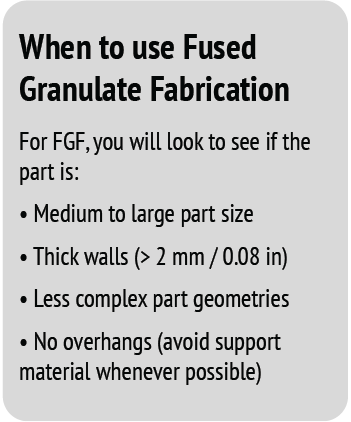What is Fused Granulate Fabrication?
Fused granulate fabrication (FGF) is an extrusion-based 3D printing technique where plastic granulates (AKA plastic pellets) are melted and fed through a nozzle. It may also be referred to as “Fused Granulate Fabrication”, “Fused Particular Fabrication”, or “Pellet 3D Printing”.
What is 3D Printing?
3D Printing, also known as Additive Manufacturing, refers to a collection of processes where materials are selectively deposited along a digitally defined path, making a three-dimensional solid object of virtually any shape layer-by-layer. Compared to traditional manufacturing processes, 3D printing offers advantages in design freedom and doesn’t require specialty tooling for production, making it a great tool for prototyping and low volume production.
The ASTM Committee F42 on Additive Manufacturing Technologies publishes official terminology standard for the industry. There are seven process classifications for additive manufacturing, including Binder Jetting, Directed Energy Deposition, Material Jetting, Powder Bed Fusion, Sheet Lamination, Vat Photopolymerization, and Material Extrusion.
Material Extrusion Technology
Material Extrusion is an additive manufacturing process where material, typically a thermoplastic, is selectively deposited through a nozzle or orifice.
This technique was invented in 1989 and is the second 3D printing process successfully commercialized. It can reliably produce prototypes, concept models, tooling (jigs, fixtures, etc) with a variety of plastics. Material Extrusion is a dominant player in the industry and continues to play a major role in additive manufacturing.
The Pellet Printing Process
At JuggerBot 3D, 3D printers utilizing Fused Granulate Fabrication incorporate robust screw and barrel technology similar to that used in traditional plastic extrusion and injection molding. Pellets are conveyed from a dryer to a hopper, where they are gravity fed to the screw. As the screw rotates, pellets are pressed through a barrel with multiple heating zones, allowing the material to progressively heat up and melt. Pressure builds up within the extruder and forces melted material out of a metal nozzle along the digitally defined tool path.
Learn more about JuggerBot 3D’s 3D printers with FGF capabilities on our products page.

Comparing FFF & FGF
Fused Filament Fabrication (FFF) is another popular material extrusion 3D printing technique. However, there are distinct differences between the two. Check out this page to learn more about the differences between each process, the difference in materials, and when to use one versus the other!
When to use Fused Granulate Fabrication
For FGF, you will look to see if the part is:
- Medium to large part size
- Thick walls (> 2 mm / 0.08 in)
- Less complex part geometries
- No overhangs (avoid support material whenever possible)
Near Net Shape Printing
Parts produced from FGF technology can be put onto traditional subtractive equipment and be milled to final part design. This is called near net shape printing. You will enlarge your part design, print it fast, then machine it down to your final dimension. With FGF technology starting with a cheaper material option, and the speed to print is upwards of 200X faster than FFF, having an additional machining cost to your production is minimal. This can also help you achieve higher production tolerances.

